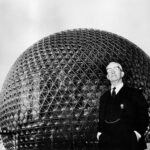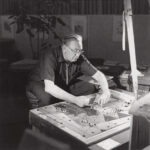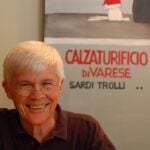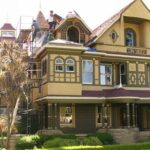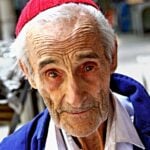Rebels of Construction—Antoni Gaudí
This part in the Rebels of Construction blog series is a guest post written by Melissa Klapuch.
The towers of the Sagrada Família have been dominating the skyline of Barcelona since 1956. Their tall, arching turrets seem to mock the nearby mountain peaks of Montserrat. The inside of the magnificent house of worship may as well have been designed to be an atrium. Decorated with all forms of natural life from ocean flora and fauna to the tree-topped columns reminiscent of the national tree of Spain, the Encina, or evergreen oak, it truly should be considered one of the wonders of the world.
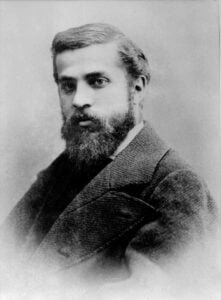 Antoni Gaudí (June 25, 1852-June 10, 1926)
Antoni Gaudí (June 25, 1852-June 10, 1926)In this structure, Antoni Gaudí gives glory to nature as you would give glory to god. His religion was nature and he chose to celebrate and exalt this spirituality in every work of his creation. The building itself is in stark contrast to the gothic cathedrals that were popular in Europe at the time. Unlike the other cathedrals of Europe, you get the sense that The Sagrada Familia LIVED, and is still living for that matter. The bright colors and shapes are indicative of the ever-changing nature OF nature itself.
The structure and history of the man who dreamed this work of art into being are equally fascinating. This is a story of a disruptor, living and breathing his dharma and his purpose. In every stroke of plaster, every line of pencil, every arch leaning into another, we see Gaudí's groundbreaking vision of what architecture can be when infused with nature.
Born on the 25th of June, 1852 in Reus, Spain, the man who would come to be known as “God’s architect”, Antoni Gaudí was born under no special circumstances for his time. And while the day of his birth may not have lent any special influence to how his life might later be defined, the location of his birth did.
Reus is located in the far East of Spain outside of Barcelona and just near enough to the Balearic Sea (part of the Mediterranean sea). Here Gaudí would spend the majority of his childhood living and learning about the environment that surrounded him, which led him to enroll in Centre Excursionista de Catalunya (or the Hiking Club of Catalonia), at the age of 27. Here he and fellow members set to task to learn as much as possible about the natural world around them, and its influences on mathematics, art, and society.
It was during this time that the seeds of Gaudí's great works began to take root.
After a brief mandatory stint in the military, Antoni Gaudí began his studies in architecture at Llotja School and the Barcelona Higher School of Architecture. Upon graduation, his professional career started small, designing lamp posts and newsstands, all the while pouring every ounce of his passion into the smallest of projects. Amazingly, those same lamp posts can be seen today in Plaça Reial.
Casa Vicens
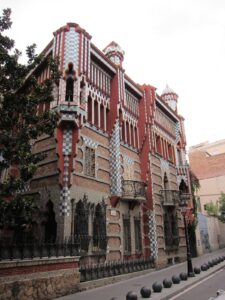 Built between 1883 and 1885, Casa Vicens still houses the original wood furniture which Antoni Gaudí designed.
Built between 1883 and 1885, Casa Vicens still houses the original wood furniture which Antoni Gaudí designed.His big break came when he was commissioned to build Casa Vicens and it is here we see the first spark of Gaudí's raging fire of influence that would come to be. Breaking from the tradition of Victorian-era style, Gaudí instead began to experiment with the concept of Neo-Mudéjar, loosely translated to “Neo-Moorish”. Gaudí combined elements not normally seen together in Spanish architecture, like ceramic tiles, and concrete, and glass. In this style, he began speaking his own language, starting a conversation in the world of architecture that continues to this day.
Completed in 1885, Casa Vicens is often cited as the structure where Gaudí is most “Gaudí”. The juxtaposition between man’s creation and the natural world can be seen at the entrance to the property in a cast-iron gate adorned with images of palm trees. More of the natural world can be found in the tiles decorated with carnation flowers, and the entire building is surrounded by a garden. Inside the house, the ceilings are covered wall to wall with tiles representing different flowers known to the area.
Catalonia Modernism
Gaudí's language, known in architectural terms as Catalonia Modernism, became known throughout the world for its heavy reliance on elements in nature. Gaudí had found a way to express his love for nature and natural elements through architecture. Often questioned for the lack of uniformity in his work, he’d then offer back: “Where in nature do you find straight lines and angles?” That being said, it’s not surprising that Gaudí’s name is mentioned in the same sentences as another famous Catalan rule-breaker, Salvador Dali. There is quite a bit of documentation on the admiration that the creator of the Surrealist art movement had for his contemporary in architecture.
Park Güell
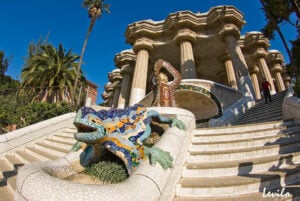 A trip to Barcelona isn’t complete without a stroll through Park Güell.
A trip to Barcelona isn’t complete without a stroll through Park Güell.One of Gaudí's most famous contributions to the movement he created is Park Güell. Its location overlooking the sea and the plain of Barcelona couldn’t have been more perfect if Gaudí had dreamed it himself. Completed in 1914 and opened to the public in 1924, the genius of Gaudí's vision can be seen in its totality. The pathways and walkways wind through the park in the most natural fashion, as they follow the original lay of the land. In the park you’ll find columns of rocks stacked, it would appear, haphazardly on top of each other in a most chaotic fashion. But such is nature, right?
In the monumental area of the park is a salamander covered in brightly colored tiles, known as “trencadís”, another technique that Gaudí helped to pioneer. One thing you won’t find in this park is straight lines, harkening back to his preference for fluidity and disruption in the natural world.
Gaudí's rebellious attitude didn’t stop in his work. Because of his ongoing issues with rheumatoid arthritis, he chose to adopt a very strict vegetarian lifestyle, which unfortunately led to additional health concerns. It’s well known that he nearly died during a Lenten fast. While most Spanish would seek aid from the closest physician, Gaudí instead chose to seek guidance from priests and naturalists. Also not so common for this time was that Gaudí held a life-long concern for the welfare of the workers who built his creations. He ensured that they were paid adequately to sustain their families during his projects. He would go on to design Colonia Guell, a workers’ community built near a mill and that also contained a hospital and multiple schools.
Sagrada Família
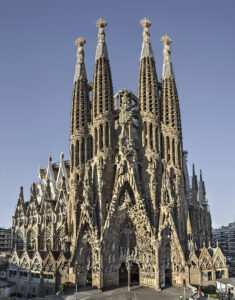 Antoni took over the design of in Sagrada Família in 1883 and continued to work on the church until his death in 1914.
Antoni took over the design of in Sagrada Família in 1883 and continued to work on the church until his death in 1914.When Gaudí was chosen to design the Sagrada Família in 1883, he was considered a very controversial choice, as he hadn’t been a practicing member of the Catholic religion for some time. However, it is said that Gaudí would make a return to the faith while he spent the last 40 years of his life in a furious attempt to complete the project.
Sadly, Gaudí would not live to see his greatest creation come to fruition. On June 10th, 1926 he was struck by a tram while on a walk to the Sagrada Familia. Sadly, he was not recognized immediately as the well-known Barcelona architect. Gaudí had always kept a modest appearance, never reveling in the lifestyle that his work had afforded him. Later in life, this modesty would be brought to another level, and Gaudí would be seen disheveled, unkempt, and donning attire that some would say might disintegrate should he be caught in a strong wind. Because of this, most nearby thought the victim of the tram accident to be a beggar and was paid little attention because of it. It was only when his body was taken to the hospital that a priest, who incidentally had held services at Sagrada Familia, recognized him as the prominent architect.
About Melissa
Melissa Klapuch found creative writing at the age of 10 when she put pen to paper in her first, super-secret diary, complete with a heart-shaped lock and a sparkly sticker that read, “KEEP OUT!” Since then, she’s been jotting down prose and short stories whenever she has free time and has recently decided to focus her professional and creative efforts on a career in copywriting and content marketing. Melissa draws inspiration from individuals who have found their passion in life and have chosen to take a leap of faith to follow it. When she’s not writing, Melissa is listening to the latest True Crime podcast or serving as the personal attendant to her three cats: Duke, Daisy, and Jack Bauer.
This post is part five of our series titled “Rebels of Construction.”
What Does it Mean to be a Rebel?
Rebels challenge conventional ways of thinking, defy rules, and revolt against those that tell them ‘no.’ Without Rebels, there would be no invention, innovation, or improvement in our society. Disrupting the status quo, a true Rebel charts a new course where all benefit. In the blog series, Rebels of Construction, Beck Technology celebrates the independent spirit of the Rebel.

-1.png?width=112&height=112&name=image%20(4)-1.png)












